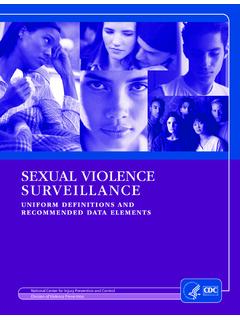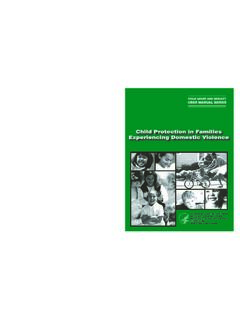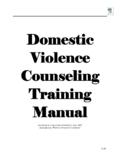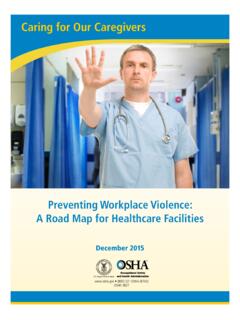Transcription of For Domestic Violence Emergency Shelters
1 SCREENING AND INTAKE FORMS For Domestic Violence Emergency Shelters Prepared by Deadria Boyland December 2016 Acknowledgements Special thanks to New Hope DV/SA Services, YWCA Yakima, New Beginnings for Battered Women and their Children, King County, Lower Valley Crisis & Support Services, Yakima County, Emergency Support Shelter, Cowlitz County, Life Wire, King County, YWCA of Clark County, YWCA of Tacoma/Pierce County, Korean Women s Association, Pierce County, Crisis Support Network, Pacific County, Domestic Violence Center of Greys Harbor County, Health Families of Clallam County, Room One, Okanogan County, Human Response Network, Lewis County, who kindly made their materials available to us and were uniformly generous with their insight.
2 I would also like to thank the advisory group who helped design the model forms and develop the questions for the screening and guidelines: Becky Jackson, New Beginnings; Erinn Gailey; Anne-Marie Schwerin, YWCA Walla Walla; Kathryn Cohen YWCA Clark County, Deidre Evans Lifewire King County, Debbie Gonzalez New Hope Grant County, Abigail Mott YWCA Yakima, Stephanie Barr YWCA Clark County. Last but not least, a special thanks to the staff at the Washington State Coalition against Domestic Violence for sharing their expertise. Special thanks to Judy Chen, Leigh Hofheimer, Becca Campbell, Reed Forester and Kelly Starr. This project was supported by the funding from the Washington State Department of Social and Health Services.
3 Points of view in this document are those of the authors and do not necessarily represent the official position or policies of the Washington State of Department of Social Health Services. Introduction One of the values of our advocacy work is to continually examine and reevaluate our practices and explore ways to improve our services on behalf of survivors. Even though our advocacy programs offer a rich array of services for survivors beyond Emergency shelter, for many people, seeking shelter is still a highly visible and commonly recognized option for help. We know that shelter is not enough. We know that survivor s needs are complex and that we often don t have the community resources that we want.
4 And yet, survivors tell us that getting through our doors can be a confusing and overwhelming experience. Survivor-centered advocacy practice pushes us to question how we are screening people who are seeking help from our programs and asks us to think about the ways we inadvertently create barriers to our services. This report describes our findings and recommendations following an assessment of the screening and intake processes of 13 Domestic Violence Shelters and 2 community-based Domestic Violence programs. Things to keep in mind Screening forms should be brief, include staff instructions and prompts, or framing introductory or explanatory sentences that help the caller understand the process.
5 Additionally, screening questions should be limited and focused on: the survivor s priorities; understanding what the survivor identifies as risks to themselves or their children; and the threats posed by the abuser that impact safety for the caller or their children. Shelter Screenings should lead with the intention to provide safety and advocacy services for individuals experiencing a range of abusive tactics from their partner. Shelter screenings should determine eligibility based on the survivor s perception and understanding of the risks they are facing from their abuser. Determination of shelter eligibility should go beyond the limited legal definitions of Domestic Violence found in statute.
6 Both shelter screenings and intake forms should include explanatory instructions and guidelines with prompts that guide the advocate and participant through the process and explain the purpose of the questions. Both shelter screenings and intake forms should include staff prompts that remind advocates to: explain the purpose of the questions; describe their advocacy services; provide information about accommodations; offer timely needed services, offer breaks during the process and check for understanding with the participant. Programs provide ongoing training for staff, volunteers and relief workers about the shelter screening and intake to build consistency and a shared understanding about the purpose of these processes.
7 1 Emergency Shelter Screening for Domestic Violence Program Tip: Please familiarize yourself with the questions ahead of time. This is a tool to assist you in understanding the needs of the participant so that you are equipped to provide the appropriate support. Are you safe right now? Yes No Language Access If needed we can provide a bilingual advocate or interpreter for this call. Yes No Language(s): _____ Confidential conversation What you share with us over the phone and in-person is confidential, and stays within this program unless you request otherwise. Caller s First Name: _____ Phone # if disconnected (optional) (_____) _____-_____ What city or town are you calling from?
8 _____ LISTEN Narrative: Can you share with me what prompted you to call our program today? When answering a shelter call generally this is what we hear first. Do you have any shelter space or I need shelter Please be aware that this may not be the thing they need. You can ask Tell me more about your housing situation. Listen SupportProvide2 SUPPORT Welcoming statement: I m sorry this happened to you, and you don t deserve to be treated this way. I hope we will be able to provide you with the resources you need and if not, guide you in the right direction. Our program welcomes everyone and we open our doors to individuals who reach out to us from different cultures, race and ethnicities, from a variety of religious backgrounds, folks with diverse gender identities and sexual orientations, folks with hidden or visible disabilities, folks who have substance use challenges, folks with money or no money just like the world around us.
9 Non-Shelter Housing options: Offer these if appropriate. Offer assistance to stay in own home Financial assistance If caller wants to stay in home link them to housing advocate or a community advocate Proceed with Screening: This is when you decide if the participant is eligible for your program services. Yes I would like to offer you a space in our shelter program. No space No DV/IPV Other _____ If the participant is not eligible for your services, remember to safety plan with caller. PROVIDE Meeting the Participant s Needs I m glad we re going to be able to provide space for you at our shelter. There are a few things I would like to share or ask you about, in order to try to meet your needs and provide you with appropriate support.
10 The next few questions are to help me understand how to help you. Your responses won t prevent you from getting services. (Optional) Unpublicized Location Our program is in an unpublicized location, and our intent is to keep the location private. We will talk a bit later about how to get here. What should you expect from our program? Provide brief overview of things people should know ahead of time ( , accessibility, length of stay, communal/non-communal living and shared spaces ( , shared bathrooms, bedrooms, kitchen), basic accommodations ( , food, financial assistance.) Diversity We have diverse people living and working here. There are usually a lot of different ages of children, and different religions, languages, and cultures, races and ethnicities, and including lesbian, gay, bisexual and transgender people.)







